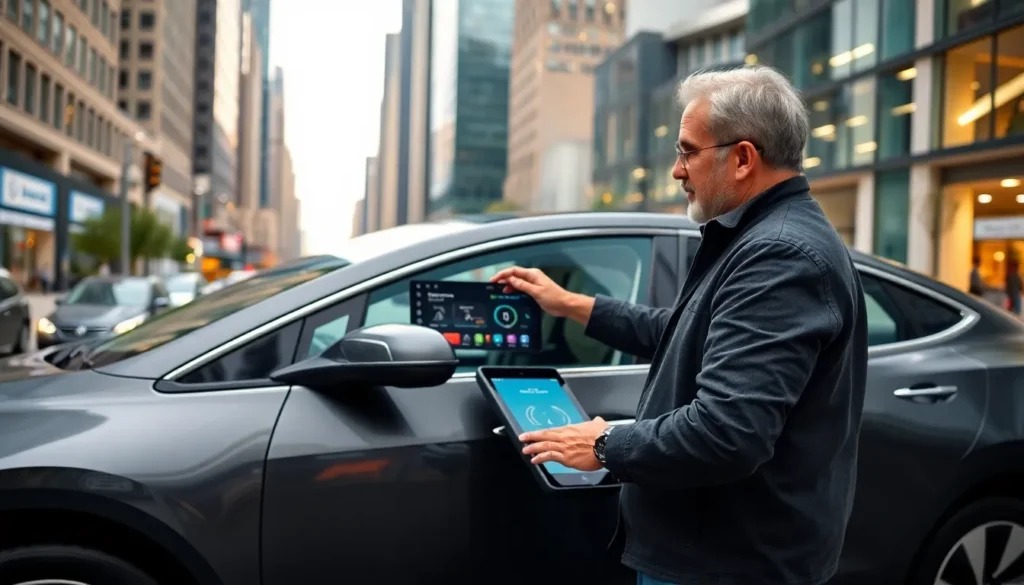Table of Contents
ToggleIn a world where cars are smarter than most of us, staying updated on automotive tech can feel like trying to teach an old dog new tricks. From self-parking wonders to infotainment systems that could probably run a small country, the automotive landscape is changing faster than you can say “vroom vroom.” It’s not just about horsepower anymore; it’s about how many apps you can fit into your dashboard.
Overview of Automotive Tech Reviews
Automotive tech reviews play a critical role in guiding consumers through the complexities of modern vehicles. These reviews evaluate cutting-edge features, enabling potential buyers to make informed decisions.
Importance of Automotive Technology
Automotive technology drives innovation in the industry. Advanced safety features, like lane-keeping assist and automatic emergency braking, enhance driver security. Infotainment systems enrich user experience, allowing seamless smartphone integration. Fuel efficiency merges with electric and hybrid technologies, addressing environmental concerns. The industry’s shift toward autonomy marks a significant step forward, with self-driving capabilities becoming increasingly viable. Understanding these advancements aids consumers in choosing vehicles that best fit their needs.
Criteria for Reviews
Several key criteria dictate the quality of automotive tech reviews. Performance assessments examine how well systems execute tasks, such as acceleration and braking dynamics. Usability evaluations focus on interface design and user-friendliness. Safety ratings reflect compliance with regulations and real-world crash tests. Durability connects to the longevity of features in various conditions. Customer feedback enhances evaluations, providing real-life insights into vehicle performance. Maintaining comprehensive and honest reviews ensures consumers receive reliable information before making purchases.
Types of Automotive Technology

Automotive technology encompasses various cutting-edge systems that enhance vehicle performance, safety, and user experience. Understanding these types can help consumers make informed choices.
Infotainment Systems
Infotainment systems integrate entertainment and information features into vehicles. They provide connectivity through apps, navigation, and audio options, enhancing the driving experience. Touchscreens, voice commands, and smartphone compatibility represent common user interfaces. Many vehicles now include built-in navigation systems, allowing drivers to access real-time traffic updates. Moreover, over-the-air updates ensure systems remain current, offering new functionalities without dealership visits.
Safety Features
Advanced safety features focus on protecting occupants and preventing accidents. Adaptive cruise control and lane-keeping assist exemplify this technology’s effectiveness. Collision avoidance systems use sensors to detect obstacles and provide alerts to drivers. Various vehicles also incorporate automated emergency braking that activates when impending collisions are detected. Furthermore, blind-spot monitoring systems enhance awareness of surroundings, contributing to safer driving conditions.
Electric and Hybrid Vehicles
Electric and hybrid vehicles represent the industry’s shift toward sustainability. Battery technology powers electric models, offering zero-emission driving. Hybrid vehicles combine an internal combustion engine with electric motors, improving fuel efficiency while reducing emissions. Regenerative braking in these vehicles captures energy during deceleration, extending driving range. Various manufacturers now offer electric options, responding to consumer demand for cleaner alternatives. These innovations contribute to reduced environmental impact and lower operating costs for drivers.
Popular Automotive Tech Products
Modern vehicles integrate advanced technologies across various categories that enhance driving experiences and safety.
Top Infotainment Systems
Renowned infotainment systems like Tesla’s interface use large touchscreens and voice recognition for seamless control. Apple CarPlay and Android Auto allow integration of smartphones, providing access to apps and navigation. Systems from brands such as BMW and Mercedes-Benz feature high-definition displays and customizable interfaces to enhance user interaction. Connectivity options that include Bluetooth and Wi-Fi improve accessibility for passengers. These infotainment advancements prioritize user convenience and entertainment during drives.
Leading Safety Technologies
Adaptive cruise control features monitor traffic and adjust speed automatically, ensuring safe distances between vehicles. Collision avoidance systems utilize sensors and cameras to detect potential threats, providing alerts and initiating braking if necessary. Lane-keeping assist technologies help maintain vehicle positioning within lanes, reducing drift. Advanced safety technologies from companies like Ford and Honda achieve impressive safety ratings in crash tests by integrating multiple features. The implementation of these technologies significantly enhances occupant protection and overall vehicle safety.
Best Electric Vehicles
Top electric vehicles such as the Tesla Model 3 offer impressive ranges, often exceeding 300 miles on a single charge. Brands like Chevrolet with the Bolt EV present competitive pricing while delivering substantial savings on fuel costs. Hyundai and Kia have introduced models that combine efficiency with stylish designs, catering to diverse consumer preferences. Tesla’s Supercharger network provides convenient charging solutions for long trips, further supporting electric vehicle use. The focus on performance, range, and affordability makes these electric vehicles attractive options for eco-conscious drivers.
The Future of Automotive Technology
Automotive technology continues to evolve at a rapid pace, showcasing exciting innovations and trends that redefine the driving experience. The shift towards connectivity and automation shapes the automotive landscape.
Emerging Trends
Connectivity drives many developments in automotive technology. Vehicles now often feature Internet of Things (IoT) integration, enhancing user experience through vehicle-to-everything communication. Safety technology also sees significant advancements; automakers increasingly rely on artificial intelligence to improve collision avoidance systems. Electric vehicles gain traction, fueled by rapidly advancing battery technology that extends range and reduces charging time. Eco-friendly innovations, such as regenerative braking, actively reduce environmental impact while promoting sustainability. Luxury features, including advanced infotainment systems with voice recognition, offer seamless access to apps and services, enhancing convenience for drivers and passengers alike.
Predictions for Upcoming Innovations
Upcoming innovations in automotive technology promise to revolutionize the industry. Autonomous driving is likely to dominate, with self-driving vehicles becoming more commonplace as regulatory environments adapt. The integration of augmented reality in heads-up displays could provide drivers with enhanced navigation and safety information. Improved battery technologies may lead to electric vehicles with greater ranges and faster charging capabilities. The incorporation of biofeedback systems could personalize the driving experience, adjusting vehicle settings based on driver comfort and preferences. Collaboration with tech companies is expected to yield more sophisticated infotainment systems, integrating seamlessly with personal devices and digital ecosystems. Understanding and adapting to these predictions will help consumers navigate the future of automotive technology.
Automotive technology is transforming the driving experience in remarkable ways. As vehicles become more connected and automated, consumers are faced with an array of choices that can be overwhelming. Automotive tech reviews play a crucial role in simplifying this process, providing insights into the latest features and innovations.
From advanced safety systems to cutting-edge infotainment options, understanding these technologies is essential for making informed decisions. As the industry continues to evolve with electric and autonomous vehicles on the horizon, staying updated on the latest trends will empower drivers to embrace the future of mobility confidently.




